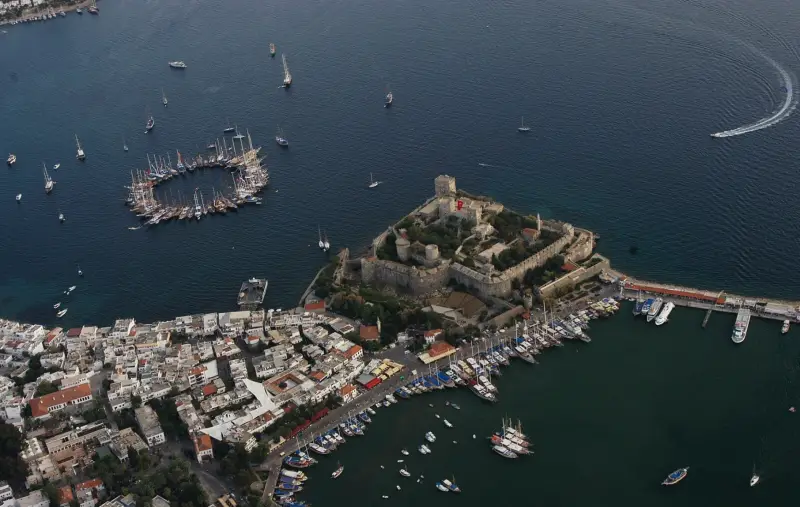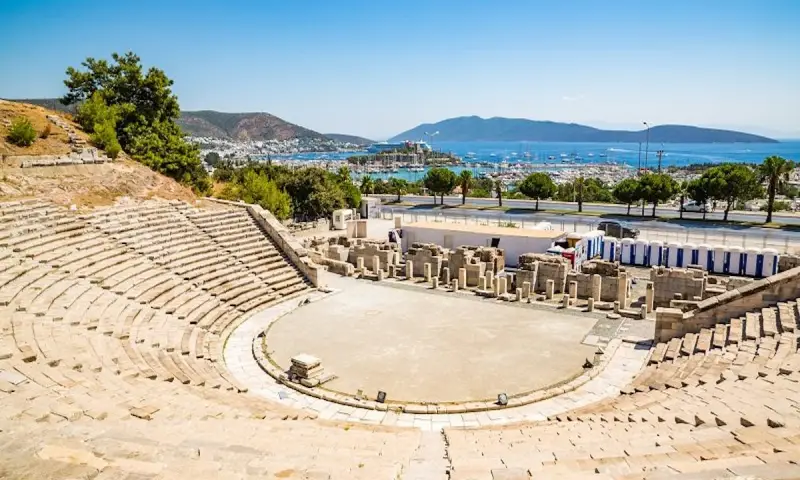The Mausoleum at Halicarnassus
The Mausoleum at Halicarnassus is an ancient monument steeped in history, its roots tracing back to the 4th century BC. Erected in what is now Bodrum, mugla, Turkey, the Mausoleum was one of the Seven Wonders of the Ancient World.
The Mausoleum was a tomb for Mausolus, the Persian Satrap (essentially a governor) of Caria, from whom the term ‘mausoleum‘ was derived. Mausolus ruled from 377 to 353 BC and moved his capital to Halicarnassus from Mylasa. He and his wife, Artemisia II (who was also his sister, as was customary in the Carian culture), were patrons of the arts and initiated several urban development projects in Halicarnassus.
After Mausolus’s death in 353 BC, his grieving widow Artemisia decided to honor him with a tomb so magnificent that it would remain in people’s memories forever. The construction was likely to have started during Mausolus’s lifetime but was continued by Artemisia after his death. Regrettably, Artemisia died just two years later, and the project was completed by the workers and craftsmen themselves.
The monument was designed by the Greek architects Satyros and Pythius, while the sculptural decoration was undertaken by four renowned Greek sculptors: Scopas, Leochares, Bryaxis, and Timotheus. Each was responsible for one side of the tomb.
The finished Mausoleum was approximately 45 meters (148 feet) high and was adorned with intricate relief sculptures. It was a synthesis of different architectural styles, blending Greek, Near Eastern, and Egyptian influences, reflecting the hybrid culture of the region.
The Museums Housing Parts of the Mausoleum
The Mausoleum stood intact for many centuries but was eventually damaged by a series of earthquakes. They led to its gradual ruin. By the 15th century, it was in a substantial state of disrepair. The Knights of St John ( occupying Bodrum castle at the time) used the stones to fortify their castle. Some of the sculptures and relief friezes adorning the Mausoleum were taken to the British Museum in the 19th century.
Location of the Mausoleum at Halicarnassus
Today,The Mausoleum at Halicarnassus is located in the modern city of Bodrum, in the Mugla Province of Turkey. Halicarnassus, the ancient name of Bodrum, was the capital of a small kingdom of Caria during the 4th century BC when the Mausoleum was built.
Only the foundations of this once grand monument remain, but the term ‘mausoleum’ continues to be used worldwide for grand tombs, in memory of its original namesake. The site of the Mausoleum is open to visitors who can see a model of the original monument and some of the remaining stone blocks and sculptural fragments. It remains a testament to the grandeur and the artistic and architectural capabilities of the ancient world.
Situated on Turkey’s southwestern coast, Bodrum is a popular tourist destination known for its Mediterranean climate, historic sites, and vibrant nightlife. The site of the Mausoleum, although mostly in ruins, remains one of the city’s most notable historic attractions.
Architecture of the Mausoleum at Halicarnassus
The Mausoleum at Halicarnassus is famous for its unique and striking architecture, which combined elements of Greek, Egyptian, and Lycian design.
The structure, measuring approximately 45 meters (148 feet) in height, had three main sections:
- The Platform or Plinth: The Mausoleum stood on a large, rectangular platform.
- The Tomb Chamber and Colonnade: Rising from the platform was a set of 36 Ionic columns, creating a colonnade around all four sides of the monument. Between these columns, there were statues, and behind the columns, there was a solid block that carried the weight of the tomb’s massive roof. Within this block of the structure, there was a room that housed the sarcophagi (stone coffins) of Mausolus and Artemisia.
- The Pyramid and the Quadriga: On top of the colonnade was a pyramid roof, which tapered to a point at a height equivalent to the rest of the building below. At the pinnacle, there was a marble quadriga: a four-horse chariot carrying statues of Mausolus and Artemisia. The pyramid had 24 steps, one for each letter of the Greek alphabet.
One of the Mausoleum’s most distinctive aspects was its extensive use of sculptural decoration. The best sculptors of the age—Scopas, Bryaxis, Timotheus, and Leochares carved bas-reliefs and free-standing figures. Each of the four sculptors was responsible for one side of the tomb. The exact subject matter of these reliefs remains a matter of debate, but it’s likely they depicted Greek mythological scenes and possibly historical scenes of Mausolus’s rule.
Over time, due to various factors, including earthquakes, much of the Mausoleum was destroyed. Visitors can see some remnants of the architecture and sculptures in the British Museum in London and at the site’s museum in Bodrum.
Sculptures of the Mausoleum at Halicarnassus
The Mausoleum at Halicarnassus was famous not only for its grand scale and architectural design but also for its elaborate decorations, particularly ts remarkable sculptures.
The decoration of the Mausoleum was a collective work of the most famous sculptors of the time. Four eminent Greek sculptors – Scopas of Paros, Leochares, Timotheus, and Bryaxis each decorated a side of the Mausoleum.
While we don’t know the exact themes and subjects of these sculptures , they must have depicted scenes from Greek mythology, and possibly scenes from the lives of Mausolus and Artemisia.
Two of the most notable surviving pieces are now in the British Museum:
- The Mausoleum Frieze:
This is a section of the frieze from the Mausoleum depicting a battle between Greeks and Amazons. - Statues of Mausolus and Artemisia:
These were among the free-standing statues that were part of the Mausoleum’s sculptural program. They show Mausolus and Artemisia in a majestic, idealized style.
Unfortunately, the many earthquakes that hit the region over centuries caused significant damage to the Mausoleum and its artworks. By the fifteenth century, the Knights Hospitaller used the stones from the damaged Mausoleum to fortify the Castle of St. Peter, also known as Bodrum Castle. This use and reuse of the stones have led to the loss of most of the original sculptures.
Despite the loss, the few remaining sculptures from the Mausoleum at Halicarnassus provide insights into the capabilities of the ancient world. It embodies an aesthetic that sought to integrate architecture with the plastic arts to create a unified, grand monument.
Visiting the Mausoleum at Halicarnassus
Visiting the site of the Mausoleum at Halicarnassus today offers a unique opportunity to step back in time. You can imagine the grandeur of one of the Seven Wonders of the Ancient World.
Location: The Mausoleum is located in the city of Bodrum, in the southwestern Aegean Region of Turkey. Bodrum is a popular tourist destination with a beautiful marina, clear blue waters, and numerous historical sites.
What to See: The actual site of the Mausoleum is largely in ruins, with only the foundation remaining. You can walk around the site and see scattered stone blocks and a few remaining sculptural fragments. Detailed descriptions are provided at the site to help visitors understand the scale and layout of the original monument.
The Museum of Underwater Archaeology:

Scale Model:
At the site, you will find a scale model of what the Mausoleum likely looked like in its prime. This gives you an idea of the grandeur of the original structure and its architectural design.
The Amphitheater:
Not far from the Mausoleum site is the ancient Bodrum Amphitheater, which offers stunning views of Bodrum and its bay. It’s worth a visit while you’re in the area.
Visit Duration:
A visit to the site of the Mausoleum typically takes about an hour. However, you may wish to spend more time in the Museum of Underwater Archaeology and exploring other attractions in Bodrum.
Best Time to Visit: The best time to visit is during the spring (April-June) or fall (September-November). The weather is more comfortable meanwhile.
If you are into history, You should read our blogs about Gobekli Tepe, Karahan Tepe and Boncuklu Tarla!









